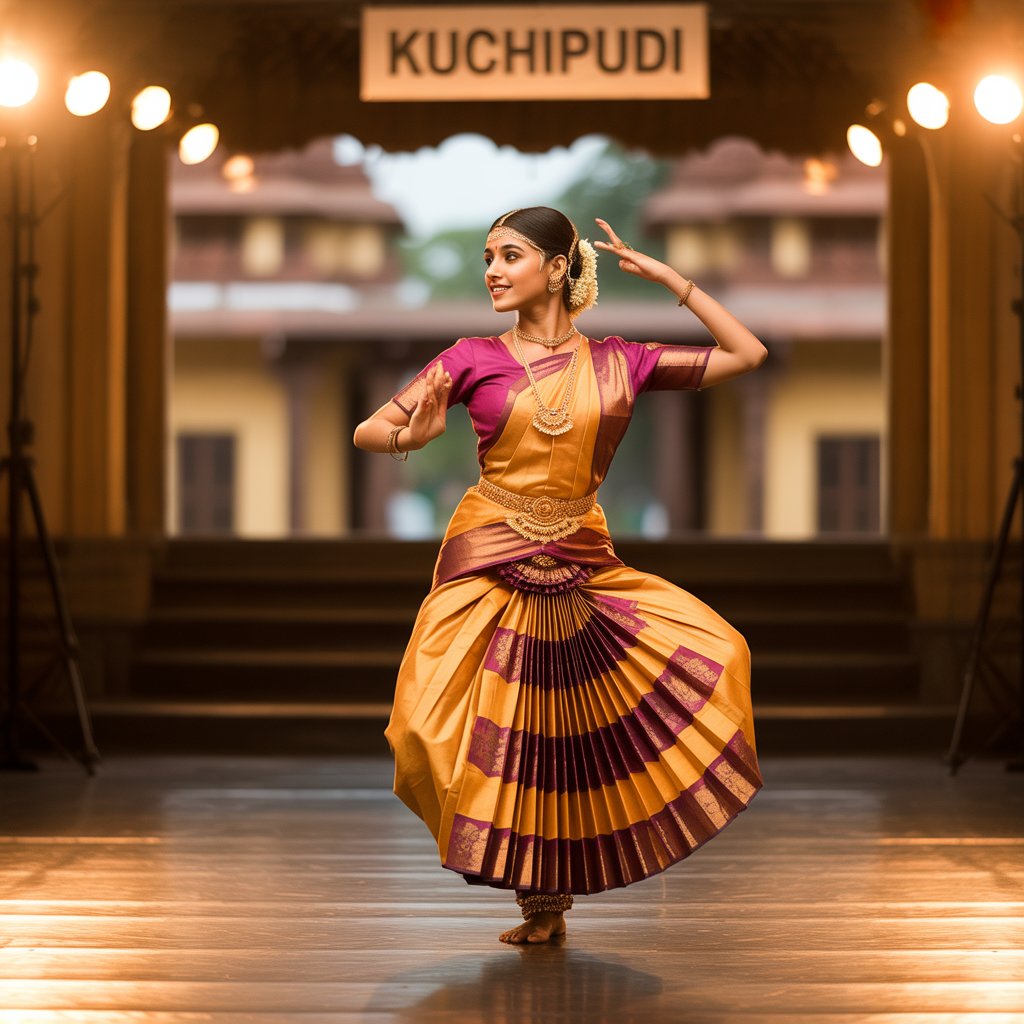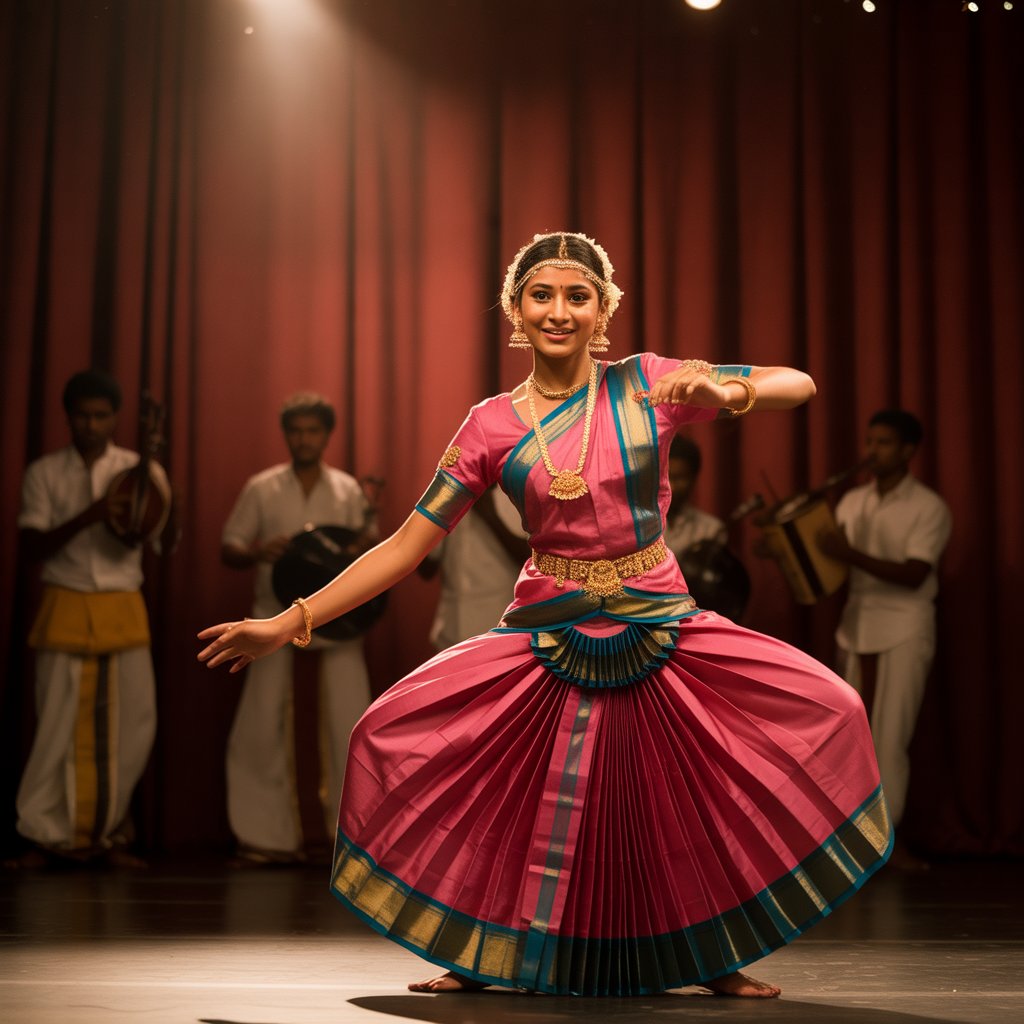If you’ve ever witnessed a Kuchipudi performance, you know it’s more than just dance – it’s a story unfolding before your eyes. The jingling of anklets, the graceful hand gestures, and the expressive eyes of the dancer all work together to draw you into a world of devotion, drama, and beauty.
Originating from a small village in Andhra Pradesh, Kuchipudi Dance has come a long way from being a simple temple ritual to a celebrated art form performed on grand stages across the world. But what makes it so unique and timeless? Let’s take a journey into the world of Kuchipudi.

1. The Origin and History of Kuchipudi Dance
Originally, only male Brahmin dancers performed Kuchipudi, often playing both male and female characters. Over time, as the art form grew, women joined in, bringing more diversity and richness to its presentation.
Inspired by the Natya Shastra, an ancient text on performing arts, Kuchipudi was designed not just to entertain, but also to educate and spiritually uplift the audience. It’s fascinating to think that what started as a temple ritual now captivates audiences in theaters worldwide.
2. The Unique Style and Characteristics of Kuchipudi
Kuchipudi isn’t just about steps and beats – it’s a conversation.
- It talks to you through expressions – those tiny eyebrow raises, those storytelling eyes.
- It blends dance and drama, making it almost theatrical.
- And yes, there’s that iconic moment when dancers balance gracefully on a brass plate (Tarangam) – an act that always leaves the audience spellbound.
Every movement in Kuchipudi is dynamic yet graceful, making it a true treat for the senses.
3. Costumes, Makeup, and Music in Kuchipudi
When you watch a Kuchipudi dancer perform, the first thing you’ll notice is the burst of colors.
- Women wear silk sarees, stitched in a way that allows them to dance freely, while men wear traditional dhotis.
- The ornaments and jewelry sparkle as the dancer moves, adding a divine touch to the performance.
- Makeup isn’t just for beauty – it’s to highlight every expression so even someone sitting in the back row can feel the story.
And then there’s the music. Carnatic tunes, the mridangam’s rhythmic beats, the soulful flute – all of it sets the mood and brings the dance alive.

4. Themes and Stories in Kuchipudi
What stories does Kuchipudi tell?
Most performances dive deep into mythological tales – stories from the Ramayana, Mahabharata, or Bhagavata Purana. These aren’t just tales of gods and heroes; they’re lessons about life, love, and righteousness.
And yet, Kuchipudi hasn’t stayed frozen in time. Modern choreographers now explore social themes, making it as relevant today as it was centuries ago.
5. Cultural Significance of Kuchipudi Dance
For the people of Andhra Pradesh, Kuchipudi is more than an art form – it’s a cultural heartbeat. It keeps Telugu traditions, language, and devotional practices alive.
Today, Kuchipudi has traveled far beyond Indian borders. From New York stages to European festivals, this beautiful dance continues to connect cultures and inspire artists worldwide.
6. Learning and Practicing Kuchipudi Today
If you’ve ever thought about learning Kuchipudi, here’s the truth: it’s a commitment. It takes years of practice, dedication, and guidance from a guru.
But here’s the beauty – whether you join a traditional dance school in Andhra Pradesh or learn online from renowned teachers, the journey itself transforms you. Kuchipudi isn’t just about dance – it’s about discovering yourself.
Conclusion
So, the next time you watch a Kuchipudi performance, remember – you’re not just seeing a dance; you’re witnessing history, devotion, and culture in motion.
FAQs on Kuchipudi Dance
It combines dance, drama, and even dialogues, with lively footwork and the unique brass plate performance (Tarangam).
It’s a way to connect with the divine – every performance is an offering to the gods.
Many traditional academies in Andhra Pradesh and global dance schools offer training. Online classes have also made it more accessible.




Pingback: "Odissi Dance: Exploring India’s Graceful Classical Art Form" - a2ztrendy.com